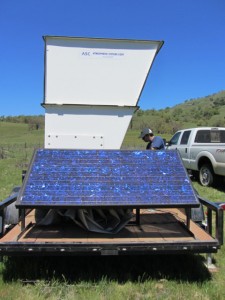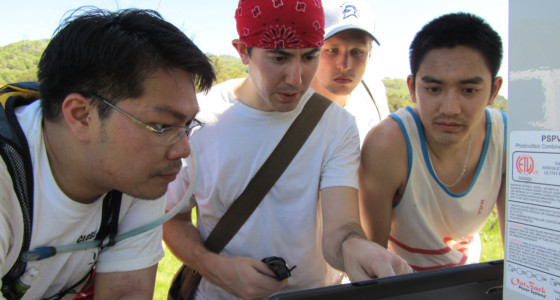
Clements and his student researchers will use this custom-designed mobile atmospheric profiling system to develop a better understanding of the physical mechanisms responsible for wildfire-atmosphere interactions (Rie Onodera image).
By Pat Lopes Harris, Media Relations Director
Craig Clements, an assistant professor with the Department of Meteorology and Climate Science, has received a $900,000 National Science Foundation grant to continue his groundbreaking research on wildfire weather.
The funding will allow Clements to obtain new observations from a comprehensive field program tracking wildfire-atmosphere dynamics, and to integrate these observations into education and community outreach.
In practical terms, this means Clements and his team of student researchers now have the funding needed to deploy their mobile atmospheric profiling system, a truck pulling a compact trailer loaded with the latest tech tools. These tools includes lidar and sodar, which use light and sound waves to track winds.
The grant will allow the team to chase wildfires (in a safe way, of course!) throughout the West. Their overall goal is to learn more about the super dynamic atmospheric conditions inside and around blazes so we can better predict wildfire behavior, saving lives and property.
Clements received this grant through The Faculty Early Career Development (CAREER) Program, the National Science Foundation’s most prestigious award in support of junior faculty members nationwide.
In 2011, Professor Clements received the SJSU Research Foundation‘s Early Career Investigator Award, which recognizes tenure-track faculty members who excel in research, scholarship and creative activity, and have secured funds for research early in their careers.
Here’s his NSF project summary.
***
PROJECT SUMMARY
The career development plan (CDP) represents an ambitious effort to advance the understanding of wildfire-atmosphere dynamics by obtaining new observations from a comprehensive field program and integrating these observations into education and community outreach. The key objectives of the CDP are:
(1) To develop a better understanding of the physical mechanisms responsible for
wildfire-atmosphere interactions and how these processes influence fire behavior.
(2) To improve student understanding of fire weather science through the development of an innovative fire science and fire safety outreach and education program.
The research component of the CDP, which expands on the PI’s field measurement experience, seeks to identify the processes responsible for fire-atmosphere interactions that affect fire behavior. The research methods are based on executing an intensive measurement program that incorporates carefully planned experiments with rapid-deploy wildfire monitoring (RaDFIRE) using the newly NSF funded CSU-MAPS, mobile atmospheric profiling system. The observational dataset will be used to study:
- The dynamics of fire-induced winds and their impact on fire behavior.
- The thermodynamic structure of fire plumes and the near-surface environment.
The education component of the CDP is a plan designed to build a university program in fire weather research that links San José State University and the community. This component will integrate fire weather content into general education courses, improve 6th grade science learning through a teacher training workshop, and develop fire danger awareness among students living in fire danger zones by providing a novel and modern fire safety education program. The component concepts are:
- Integration of fire weather content into university courses.
- K-12 Teacher Training workshop called Weather of Wildfires.
- Red-Flag Days: A community outreach program for middle schools in the Wildland-Urban Interface aimed at providing fire safety education.
Intellectual merit. The proposed CDP will potentially transform wildfire research by measuring critical wildfire-atmosphere properties that have rarely been observed. This will provide the first comprehensive data set for the validation of coupled atmosphere-fire modeling systems. New observations of extreme fire-induced winds and plume thermodynamic structure will lead to major advances in knowledge and understanding of wildfire dynamics. Resources at the PI’s institution including CSU-MAPS are adequate for the proposed work. Educational activities are developed to improve student understanding of fire weather processes by developing new teacher training modules and a novel middle-school program aimed at fire danger awareness with the use of red flags as fire weather props.
Broader impacts. The expected outcomes of the proposed CDP include:
- Greater understanding of critical fire-atmosphere processes responsible for extreme fire behavior.
- Increased firefighter and public safety from the development of better prediction tools.
- Support for graduate and undergraduate students and postdoctoral training.
- Integrated university curriculum on fire weather and teacher training program.
- Improved fire danger awareness targeted to students at underrepresented middle schools.
- Field program will provide unique hands-on training for graduate and undergraduate students.

